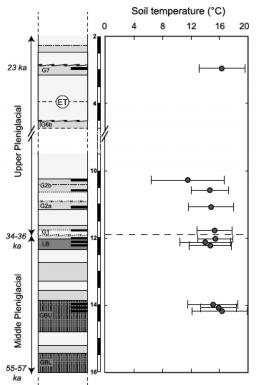Palaeotemperature reconstruction during the Last Glacial from d18O of earthworm calcite granules from Nussloch loess sequence, Germany

Soil temperatures inferred from the δ18O values of earthworm calcite granules for profile P8 at Nussloch, Germany. The upper part of the section represents the temperatures corresponding to the five selected tundra gleys horizons while the lower part represents the temperatures corresponding to the six selected boreal brown soils. The bars illustrate the standard deviations (1σ) associated with the mean oxygen isotope ratios
The Nussloch loess–palaeosol sequence (Rhine Valley, Germany) is considered to be one of the most complete records of the last glacial period in Western Europe due to its very high sedimentation rate and its good chronological control. This sequence is therefore a good framework in which to develop new proxies for palaeoenvironmental reconstructions. In this study, we explore, for the first time, the potential of earthworm calcite granules as a new bio-indicator and climatic proxy of absolute air and soil temperature in the context of Last Glacial loess. These granules are composed of rhomboedric calcite crystals, organized in a radial crystalline structure. As these granules are individually generated by earthworms at a relative fast rate, they are expected to record intra-annual variations in the available sources of oxygen: percolating waters of meteoric origin. We extracted thirty earthworm calcite granules from 11 of 5 cm layers thick from tundra gley and brown soil horizons previously, dated at 45 to 23ka.
Oxygen isotope ratios were measured on each individual granule. The δ18O of calcite granules and interlinked transfer functions between water cycle, air and soil temperaturesallowed us to estimate air temperatures ranging from 10 to 12±4â—¦C, which most likely reflect the warm periods of the year when earthworms were the most active.
C.Prud'homme , C. Lécuyer, P.Antoine, O.Moine, C. Hatté, F. Fourrel, F. Martineau et al
(2016) Earth and Planetary Science Letters, 442, 13-20.






